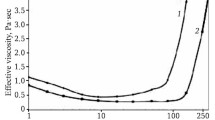Chemical composition, physicomechanical properties, mineral composition, and crystallographic properties are specified for high-alumina bauxites (predominantly Chinese) applied to refractory manufacture, prepared by HCBS-technology. Technology is developed for HCBS preparation of composite composition (bauxite + very fine quartz glass, i.e., HCBS) and refractories based on them with improved thermomechanical properties.




Similar content being viewed by others
References
Yu. E. Pivinskii, Ceramic and Refractory Materials, in 3 Vol., Vol. 2 [in Russian], Stroizdat, St. Petersburg (2003).
Yu. E. Pivinskii, Rheology of Dispersed Systems, HCBS, and Ceramic Concretes. Elements of Nanotechnology in Silicate Materials science, in 3 Vol., Vol. 3 [in Russian], Politekhnika, St. Petersburg (2012).
Yu. E. Pivinskii, E. A. Doroganov, D. A. Dobrodon, “Materials using high-alumina bonding slurries, properties of blended mullite — fine-ground fused silica binders,” Refract. Indust. Ceram., 38(11/12), 409 – 413 (1997).
Yu. E. Pivinskii, D. A. Dobrodon, I. V. Galenco, et al., “Materials based on highly concentrated ceramic binding suspensions (HCBS). Comparative evaluation of the properties and in-service durability of pocket blocks of intermediate ladies,” Refract. Indust. Ceram., 38, No. 9, 365 – 368 (1997).
Yu. E. Pivinskii, D. A. Dobrodon, E. V. Rozhkov, et al., “Materials based on high-density ceramic binding suspensions. Pressing of refractories using bauxite based high-density ceramic binding suspensions,” Refract. Indust. Ceram., 38(3), 106 – 110 (1997).
Yu. E. Pivinskii, D. A. Dobrodon, E. V. Rozhkov, et al., “Materials based on highly concentrated ceramic binding suspensions (HCBS). Evaluation of methods for molding bauxite ceramic concretes,” Refract. Indust. Ceram., 38(5), 180 – 183 (1997).
D. A. Dobrodon and Yu. E. Pivinskii, “Fabrication and properties of binders for high-alumina suspensions. 1. HCBS based on bauxite,” Refract. Indust. Ceram., 41(5), 204 – 210 (1997).
Yu. E. Pivinskii and D. A. Dobbrodon, “Preparation and properties of binder high-alumina suspensions in the bauxite – quartz glass system,” Novye Ogneupory, No. 5, 19 – 26 (2002).
Yu. E. Pivinskii and V. Yu. Belousova, “Materials based on highly concentrated ceramic binding suspensions (HCBS). Corundum–mullite ceramic castables based on plasticized HCBS of bauxite,” Refract. Indust. Ceram., 40(9/10), 391 – 395 (1999).
Yu. E. Pivinskii, P. V. Dyakin, S. S. Ordan’yan, et al., “Technology for Preparing Sintered Ceramics Based on Bauxite HCBS,” Refract. Indust. Ceram., 45(2), 124 – 130 (1999).
Yu. E. Pivinskii, Pavel V. Dyakin, and Petr V. Dyakin, “Pressure—molded high alumina ceramic castables. 3. Effect of processing additives on pressure—induced compaction and properties of bauxite quartz glass matrix systems,” Refract. Indust. Ceram., 47(2), 132 – 138 (2006).
E. M. Grischpun, Yu. E. Pivinskii, E. V. Rozhkov, et al., “Production and service of high alumina ceramic castables. 1. Ramming mixtures based on modified bauxite HCBS,” Refract.Indust. Ceram., 41(3), 104 – 108 (2000).
E. V. Rozhkov, Yu. E. Pivinskii, M. Z. Naginskii, et al., “Production and service of high–alumina ceramic castables. 2. Properties and service of vibration-placed castables based on bauxite-modified highly concentrated binding suspensions (HCBS) for use in blast–furnace runners,” Refract. Indust. Ceram., 42(5/6), 209 – 215 (2001).
E. M. Grishpun and Yu. E. Pivinskii, “HCBS and ceramic concretes – breakthrough in refractory technology of the XXI century,” Novye Ogneupory, No. 2, 28 – 33 (2002).
E. M. Grishpun and Yu. E. Pivinskii, “Twenty year epoch of cooperation,” Novye Ogneupory, No. 1, 15 – 25 (2007).
A. M. Gorokhovskii, L. A. Karpets, G. V. Pol’shchikov, et al., “Improvement of mullite-corundum composition refractories,” Novye Ogneupory, No. 11, 9 – 10 (2004).
Yu. E. Pivinskii, E. M. Grishpun, and A. M. Gorokhovskii, “Development of technology, production, and service of molded and unmolded refractories based on HCBS,” Novye Ogneupory, No. 5, 29 – 39 (2015).
I. D. Kashcheev, K. K. Strelov, and P. S. Mamykin, Refractory Chemical Technology [in Russian], Intermet Inzhiniring, Moscow (2007).
I. Allentshtein, et al., Refractory Materials. Structure, Properties, and Testing: Handbook (H. Rouchka, editor) [Russian translation], Intermet Inzhiniring, Moscow (2010).
Yu. E. Pivinskii, Unmolded Refractories, in 2 Vol., Vol. 1. General Questions of Technology [in Russian], Teploenergetik, Moscow (2003).
P. Sepulveda, A. R. Studart, and V. C. Pandolfelli, “Characterization and properties of refractory grade bauxites,” Interceram, 48(6), 398 – 406 (1999).
H. Peng and V. Mikhr, Effect of fine bauxite particles and cement content on operating characteristics and high-temperature properties of refractory concretes based on bauxite,” Ogneupory Tekhn. Keram., No. 7/8, 60 – 64 (2011).
Z. Xiangchong, “Refractory bauxite the next generation,” Industrial Minerals No. 1, 54 – 61 (2006).
V. A. Perepelitsyn, A. D. Buravov, et al., “Chinese high-alumina chamotte materials science,” Novye Ogneupory, No. 3, 21 – 22 (2015).
V. A. Perepelitsyn, I. V. Kormina, and P. A. Karpets, “Refractory bauxite substance composition and properties,” Novye Ogneupory, No. 8, 66 – 73 (2005).
“Use of highly fired andalusite in calcined objects and low-cement concretes,” News of Ferrous metallurgy Abroad, No. 3, 83 – 86 (2006).
Yu. E. Pivinskii,” Nanodispersed silica and some aspects of nanotechnologies in the field of silicate materials science. Part 2,” Refract. Indust. Ceram., 48(6), 435 – 443 (2007).
Yu. E. Pivinskii and P. V. Dyakin, “Research in the area of preparing materials based on fuzed quartz HCBS. Part 1. Comparative evaluation and distinguishing features of quarts ceramic and refractory technology,” Refract. Indust. Ceram., 58(4), 311 – 317 (2014).
Author information
Authors and Affiliations
Corresponding author
Additional information
Translated from Novye Ogneupory, No. 8, pp. 16 – 23, August 2015.
Rights and permissions
About this article
Cite this article
Pivinskii, Y.E., Dyakin, P.V. & Perepelitsyn, V.A. Research in the Field of Preparing Molded and Unmolded Refractories Based on High-Alumina HCBS. Part 1. High-Alumina Bauxite as a Basic Raw Material Component. Refract Ind Ceram 56, 344–350 (2015). https://doi.org/10.1007/s11148-015-9845-x
Received:
Published:
Issue Date:
DOI: https://doi.org/10.1007/s11148-015-9845-x




